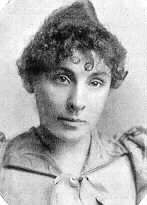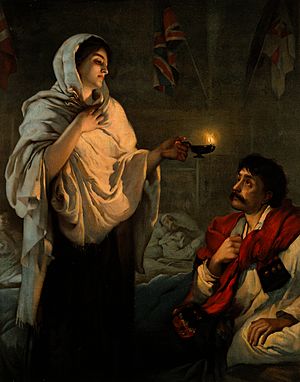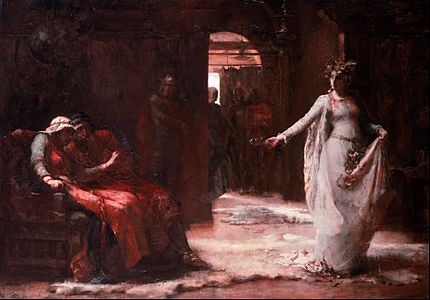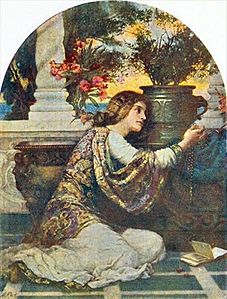Henrietta Rae facts for kids
Quick facts for kids
Henrietta Rae
|
|
|---|---|

Henrietta Rae, date unknown
|
|
| Born |
Henrietta Emma Ratcliffe Rae
30 December 1859 Hammersmith, London, England
|
| Died | 26 January 1928 (aged 68) Upper Norwood, England
|
| Nationality | British |
| Education | Academy Julien, Paris |
| Known for | Painter, writer |
|
Notable work
|
The Lady with the Lamp |
| Movement | Victorian art |
| Spouse(s) | Ernest Normand, painter (1857–1923) |
Henrietta Emma Ratcliffe Rae (born December 30, 1859 – died January 26, 1928) was a British artist from the late Victorian era. She was known for painting pictures about classic stories, myths, and books. Her most famous painting is The Lady with the Lamp (1891), which shows Florence Nightingale helping soldiers in a hospital at Scutari.
Contents
Henrietta Rae's Life Story
Henrietta Rae was born in Hammersmith, London, on December 30, 1859. Her father, Thomas Burbey Rae, worked for the government. Her mother, Ann Eliza Rae, was a musician who had studied with the famous composer Felix Mendelssohn. Henrietta had three brothers and three sisters.
Becoming an Artist
Henrietta started formally studying art when she was thirteen. She went to the Queen Square School of Art, Heatherley's School of Art (where she was the first female student!), and the British Museum.
She tried to get into the Royal Academy of Arts many times. Finally, she won a scholarship that allowed her to study there for seven years. Her teachers included Sir Lawrence Alma-Tadema, who greatly influenced her art. Other teachers were Frank Bernard Dicksee and William Powell Frith.
Marriage and Home Life
In 1884, Henrietta married Ernest Normand, who was also a painter and a student at the Royal Academy. She decided to keep her maiden name, Rae. This was unusual at the time, but she had already started to become a well-known artist. She had been showing her paintings at the Royal Academy's yearly exhibitions since 1881.
Henrietta and Ernest lived in Holland Park, a neighborhood where many other artists lived. Famous artists like Frederic Leighton, John Everett Millais, Valentine Cameron Prinsep, and George Frederick Watts often visited them.
Sometimes, these older artists could be a bit much. Henrietta wrote in her memories that some of them were bossy. Once, Prinsep dipped his thumb in blue paint and marked one of her paintings. Henrietta got back at him by "accidentally" burning his hat on her stove!
Travel and Family
In 1890, Henrietta and Ernest traveled to Paris to study art at the Académie Julian. Their teachers there were Jules Joseph Lefebvre and Jean-Joseph Benjamin-Constant.
In 1893, they moved to Upper Norwood. Ernest's father built a special art studio just for them. Henrietta and Ernest had two children: a son born in 1886 and a daughter born in 1893.
Exhibitions and Activism
Henrietta Rae showed her artwork at the Palace of Fine Arts and The Woman's Building during the 1893 World's Columbian Exposition in Chicago, Illinois.
She also supported feminism and women's suffrage, which meant she believed women should have equal rights, including the right to vote. In 1897, Henrietta organized an exhibition of art by female artists for the Jubilee of Queen Victoria.
Henrietta Rae passed away on January 26, 1928, in Upper Norwood.
Her Amazing Artworks
Henrietta Rae was known for paintings that showed scenes from classical myths, stories, and famous books.
Her painting Elaine Guarding the Shield of Lancelot (1885) was inspired by the poem Lancelot and Elaine by Alfred, Lord Tennyson. Another classical painting, Eurydice Sinking Back to Hades (1886), won an award at the 1889 International Exhibition in Paris and a medal at the 1893 World's Columbian Exposition in Chicago.
Her 1891 painting, Miss Nightingale at Scutari (1854), shows Florence Nightingale, who is known as the founder of modern nursing. This painting has been copied many times and is usually called The Lady with the Lamp.
Rae's Psyche at the Throne of Venus (1894) is a very large painting, about 12 by 7 feet, and shows 13 figures. Her painting Sir Richard Whittington Dispensing His Charities (1900) shows Richard Whittington, a medieval merchant who was the Lord Mayor of London four times. She also painted portraits of many important people, like Lord Dufferin in 1901.
Here are some of her other works:
- Love's young dream (1883)
- Elaine guarding the shield of Lancelot (1885)
- Ariadne (1885)
- Eurydice Sinking Back to Hades (1886)
- Zephyrus and Flora (1888)
- Miss Nightingale at Scutari (1854) (1891)
- Psyche at the throne of Venus (1894)
- Apollo and Daphne (1895)
- Diana and Calisto (1899)
- Sir Richard Whittington dispensing his Charities (1900) (a mural at the Royal Exchange, London)
- The Marquess of Dufferin and Ava (1901)
- Hylas and the water nymphs (1910)
- John Horner 1858-1919 (1913; Ulster Museum, Belfast)
Gallery
See also
 In Spanish: Henrietta Rae para niños
In Spanish: Henrietta Rae para niños






